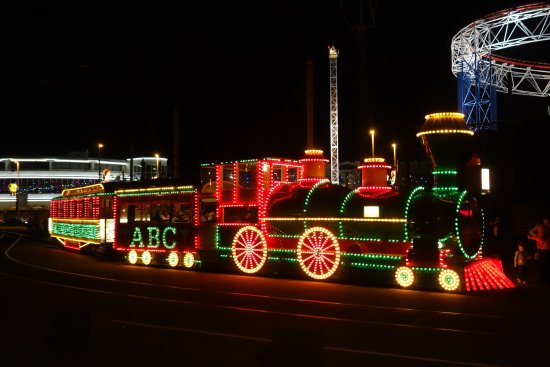The RNLI Lifeboat station in Blackpool doesn’t get anywhere near the amount of recognition that it should do. At this time of year, when more people are enjoying the beach, maybe drinking more alcohol than usual or just not taking care when they are in the sea, the lifeboat service need to constantly be on standby. We are in awe of the teamwork and professionalism of the brave people who work tirelessly and on a voluntary basis for the RNLI in Blackpool. How much do you know about the Blackpool lifeboat station and it’s history? We thought we’d show some respect to the Blackpool RNLI by bringing you an article about the history of the lifeboat station.
Early Days
The Blackpool Lifeboat Station was first established by the RNLI in 1864. It was officially declared open by the daughter and the widow of Mr R W Hopkins, who had lived in Preston and the centre was named “Robert William” to honour his memory. The structure was built at a cost of £170, which at the time would have been a lot of money.

A Dangerous Job
On the occasion of Lord Derby’s planned visit to Blackpool in 1880, a member of the crew, named J Rimmer, was fatally injured. He was preparing the lifeboats for the event when one of his feet was run over by the carriage. He would later de from his injury.
Coxswain Robert Bickerstaffe was nominated for a silver medal for his bravery and skill during the rescue of 4 people. On 26th February 1880, a strong north west gale had wrecked the schooner Bessie Jones on Salthouse Bank. Bickerstaffe retired in 1887 and was awarded the Silver Medal for this occasion in recognition of his bravery and service.
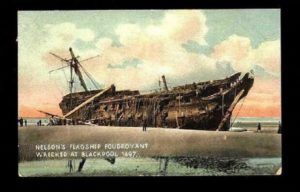
In 1897, Lord Nelson’s Flagship Foudroyant was wrecked in a storm out at sea. It had been in Blackpool as an exhibition. The Blackpool Lifeboat Station rescued 20 people onboard.
In 1923, the Honorary Secretary, Mr Tatham, along with Mr Flowers, a station committee member, were both awarded aneroid barometers in recognition of their services in a shore boat case in Fleetwood. Mr Tatham’s 10 year old son also was gifted with a copy of “Britain’s Lifeboats”.
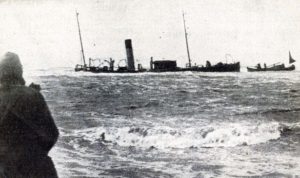
Pilot boat Charles Livingstone was swept aground in adverse weather conditions in November 1939. 6 lifeboats took part in the search and rescue operation for this emergency and 2 of the crew were washed out of the lifeboat but thankfully they were recovered. In recognition of their efforts during this rescue, Coxswain R Parr was awarded a silver medal and Mechanic Thomas E Rimmer was awarded a bronze medal.
To recognise the Blackpool Lifeboat Station’s service to the community, it was awarded the Centenary Vellum in 1964.
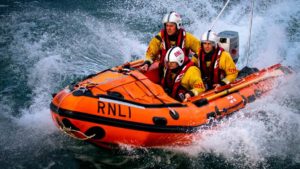
A D class inflatable lifeboat was used in a rescue operation in July 1980 when the lifeboat station was alerted that a woman was in danger. The woman was unconscious when she was pulled from the water and was given CPR by two of the crew members, Keith Horrocks and Peter Canham. The woman made a full recovery and both the crew members responsible for saving her life were awarded scrolls by the Liverpool Shipwreck Association.
In total, 6 medals have been awarded to volunteers from the Blackpool Lifeboat Station. Three silver medals and three bronze have been awarded up until 1988 when the last one was awarded.

Improvements to the Service
In 1885, a new SR Lifeboat was placed in service. It was named the Samuel Fletcher of Manchester ON74 and cost £74 to produce.
The Hon Secretary decided in 1886 that a more reliable means for alerting the crew should be sought. Coxswain Robert Bickerstaffe had managed to regain the lifeboat after he was washed out of it. The bell that was in place was not an effective way to alert his team members that he was in difficulty so a messenger was used instead of the bell.
In 1896, the Blackpool lifeboat Station asked the RNLI for funds to provide instruments and uniform for the local Lifeboat Bans. In addition, in the same year, a Watson Class Lifeboat, also named Samuel Fletcher of Manchester ON393 was placed in service. It cost £591 to produce.
In 1930, Samuel Fletcher of Manchester was replaced by the Liverpool Class lifeboat, John Rowson Lingard ON542, which had already been in service at the Mablethorpe Lifeboat Station. In addition, a tractor was added to help launch the lifeboats over soft sand and in shallow water.

In order to house a new motorised lifeboat, a new lifeboat house was built near Central Pier and a year later, in 1937, another Liverpool Class lifeboat, the Sarah Ann Austin ON800 was placed in service. That boat cost £3895 to produce and came with a launching tractor. The Duke of Kent had just been named as the President of the RNLI and the naming ceremony for the boat and the opening of the new lifeboat house was his first engagement after taking the title.
A number of lifeboats have been purchased for Blackpool’s Lifeboat Station in memory of loved ones or using funds donated to the charity when supporters pass away. Two D class lifeboats were named after two local supporters in 2010 who left sums of money to the RNLI in their will.
The most recent lifeboat to be placed in service in Blackpool was the Atlantic 85 B-867 William & Eleanor in April 2013. It was funded by William James Seed.
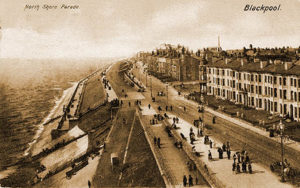
Changes in Blackpool Affected the Service
During the turn of the century, there were major improvements being made to Blackpool to bring it up to date and to encourage more tourists to visit the area. Whilst these improvements were necessary for the town, it created a huge inconvenience to the lifeboat service. In 1904, when the promenade was being widened, the number of slipways were greatly reduced, to just one. This meant that the lifeboat has to be taken half a mile along the promenade from the lifeboat station before reaching the only slipway.
A positive outcome that came from Blackpool’s modernisation however was the introduction of electric lights in the lifeboat house in 1907. This would have made night time rescues much easier for the lifeboat volunteers.
How To Support The RNLI
It costs approximately £483,000 per day for the RNLI to continue to run the lifeboat service. This requires a large amount of funding to maintain. There are a variety of ways in which people can support the charity by making a donation, leaving a gift in a will, giving a donation in memory of a loved one, participating in an RNLI fundraising event and by playing the lifeboat lottery as well as many more options. You can find out more about ways to support the RNLI by visiting their website.







